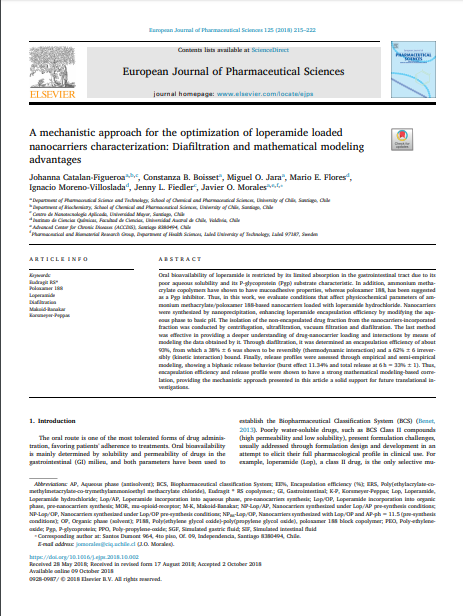A mechanistic approach for the optimization of loperamide loaded nanocarriers characterization: Diafiltration and mathematical modeling advantages

Fecha
2018Autor
Catalán-Figueroa, Johanna [Univ Mayor, Ctr Nanotecnol Aplicada, Santiago, Chile]
Fiedler, Jenny L. [Univ Mayor, Ctr Nanotecnol Aplicada, Santiago, Chile]
Boisset, Constanza B.
Jara, Miguel O.
Flores, Mario E.
Moreno-Villoslada, Ignacio
Morales, Javier O.
Ubicación geográfica
Notas
HERRAMIENTAS
Acceda a títulos restringidos
¿Cómo descargar?Resumen
Oral bioavailability of loperamide is restricted by its limited absorption in the gastrointestinal tract due to its poor aqueous solubility and its P-glycoprotein (Pgp) substrate characteristic. In addition, ammonium methacrylate copolymers have shown to have mucoadhesive properties, whereas poloxamer 188, has been suggested as a Pgp inhibitor. Thus, in this work, we evaluate conditions that affect physicochemical parameters of ammonium methacrylate/poloxamer 188-based nanocarriers loaded with loperamide hydrochloride. Nanocarriers were synthesized by nanoprecipitation, enhancing loperamide encapsulation efficiency by modifying the aqueous phase to basic pH. The isolation of the non-encapsulated drug fraction from the nanocarriers-incorporated fraction was conducted by centrifugation, ultrafiltration, vacuum filtration and diafiltration. The last method was effective in providing a deeper understanding of drug-nanocarrier loading and interactions by means of modeling the data obtained by it. Through diafiltration, it was determined an encapsulation efficiency of about 93%, from which a 38% +/- 6 was shown to be reversibly (thermodynamic interaction) and a 62% +/- 6 irreversibly (kinetic interaction) bound. Finally, release profiles were assessed through empirical and semi-empirical modeling, showing a biphasic release behavior (burst effect 11.34% and total release at 6 h = 33% +/- 1). Thus, encapsulation efficiency and release profile were shown to have a strong mathematical modeling-based correlation, providing the mechanistic approach presented in this article a solid support for future translational investigations.
Coleccion/es a la/s que pertenece:
Si usted es autor(a) de este documento y NO desea que su publicación tenga acceso público en este repositorio, por favor complete el formulario aquí.